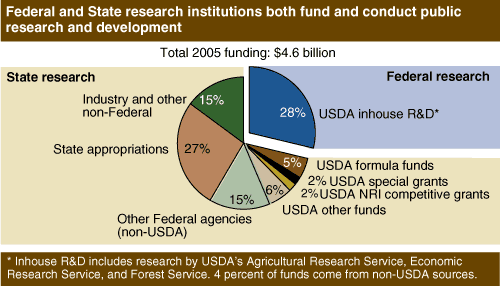Sources of Public Agricultural R&D Changing
- by Kelly Day Rubenstein, Paul Heisey and David Schimmelpfennig
- 6/1/2007
Public (Federal and State) research and development (R&D) have driven much of the growth in agricultural productivity through development of higher yielding crop varieties, better livestock breeding practices, and other improvements in farm production. Public-sector research in the USDA Land-Grant System also includes research on forestry, human nutrition, the environment, and rural development.
Total expenditures on agricultural research in the public sector increased from about $4.5 billion in 1995 to $4.6 billion in 2005, when adjusted for inflation. Research expenditures at State-level institutions, such as land-grant universities, accounted for most of the growth in public R&D; expenditures increased at about 2 percent annually between 1970 and 2005, in real terms. The rate of increase for research expenditures at Federal agencies was 0.2 percent annually.
Considering research expenditures only in terms of the broad category of public research, however, does not give a complete picture of changing funding sources. The changes reflect differing rates of growth over time in the many sources of funding which, besides USDA and State funding, includes funding from other Federal sources, industry, and other miscellaneous sources, such as private foundations.
Federal and State institutions both fund and conduct public R&D. State Agricultural Experiment Stations’ (SAES) and other cooperating institutions’ expenditures accounted for 72 percent of all public agricultural R&D in 2005, while expenditures at USDA agencies made up the remaining 28 percent. Internal sources account for almost all of USDA’s inhouse research expenditures.
USDA administers several instruments used for “extramural” (outside the Department) research programs, largely at State land-grant institutions. “Formula funds” are distributed to SAES based on a State’s population (and related factors), for use at the SAES’ discretion. In 2005, formula funds from USDA accounted for $221 million of State-level expenditures. USDA’s National Research Initiative (NRI) awards research funds through a competitive process. In 2005, NRI research grants made up 2 percent of total public agricultural R&D expenditures ($89 million). Another 2 percent of expenditures came from “special research grants” designated (or earmarked) by Congress.
While USDA’s contribution to State-level R&D expenditures has diminished over time, funds from other Federal agencies have increased. These funds, which are generally awarded competitively, tripled between 1980 and 2005 in real terms, to $678 million in expenditures for 2005. Between 1980 and 2005, expenditures arising from industry and other non-Federal funds grew by around 70 percent, reaching $695 million in 2005.
The increasing presence of nontraditional sources of agricultural research expenditures sometimes leads to creative collaborations to advance mutual goals. For example, a small State investment in an Iowa State University’s bioinformatics program (the merging of information science and biotechnologies) helped secure $3 million in additional grants from the National Science Foundation and a major industry leader.
This article is drawn from:
- Agricultural Research and Productivity. (n.d.). U.S. Department of Agriculture, Economic Research Service.



